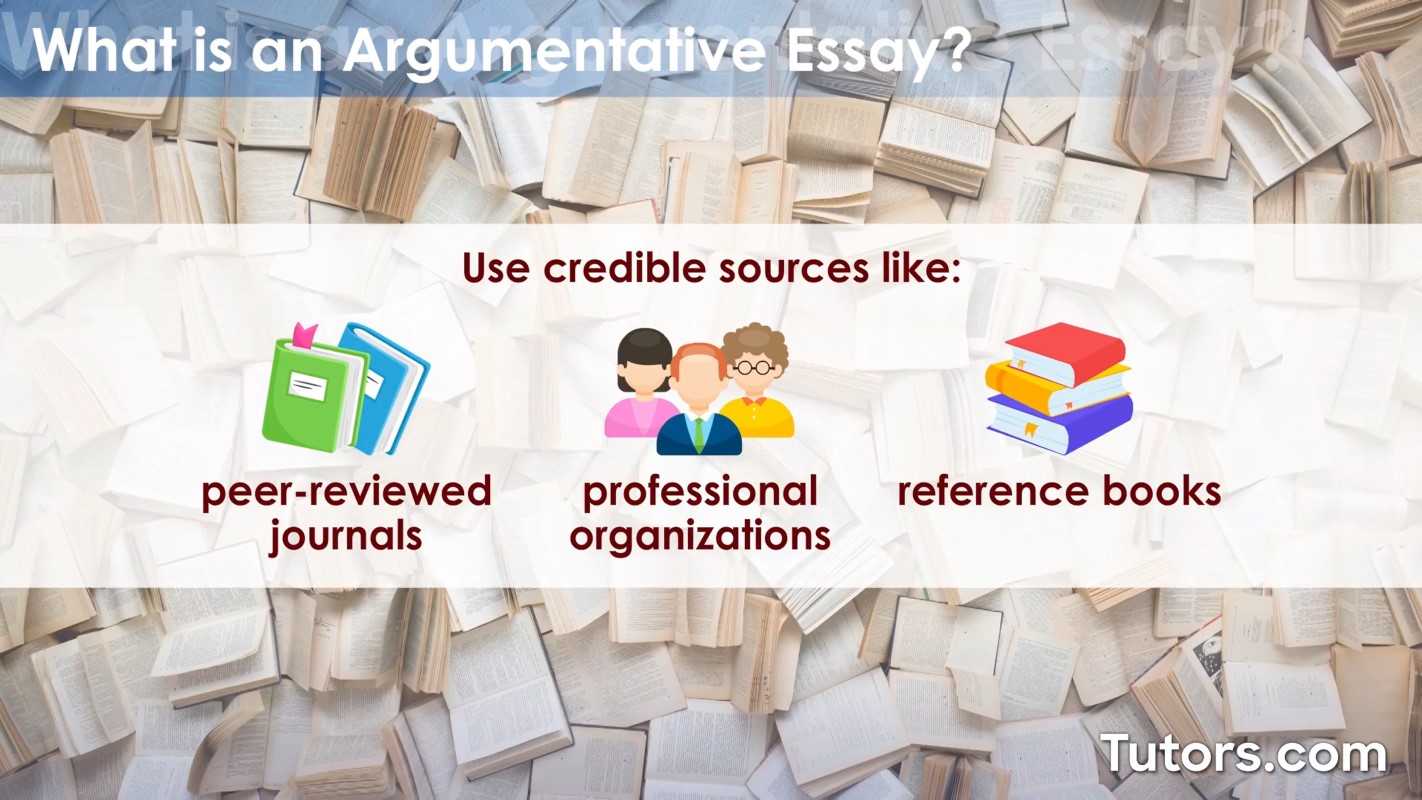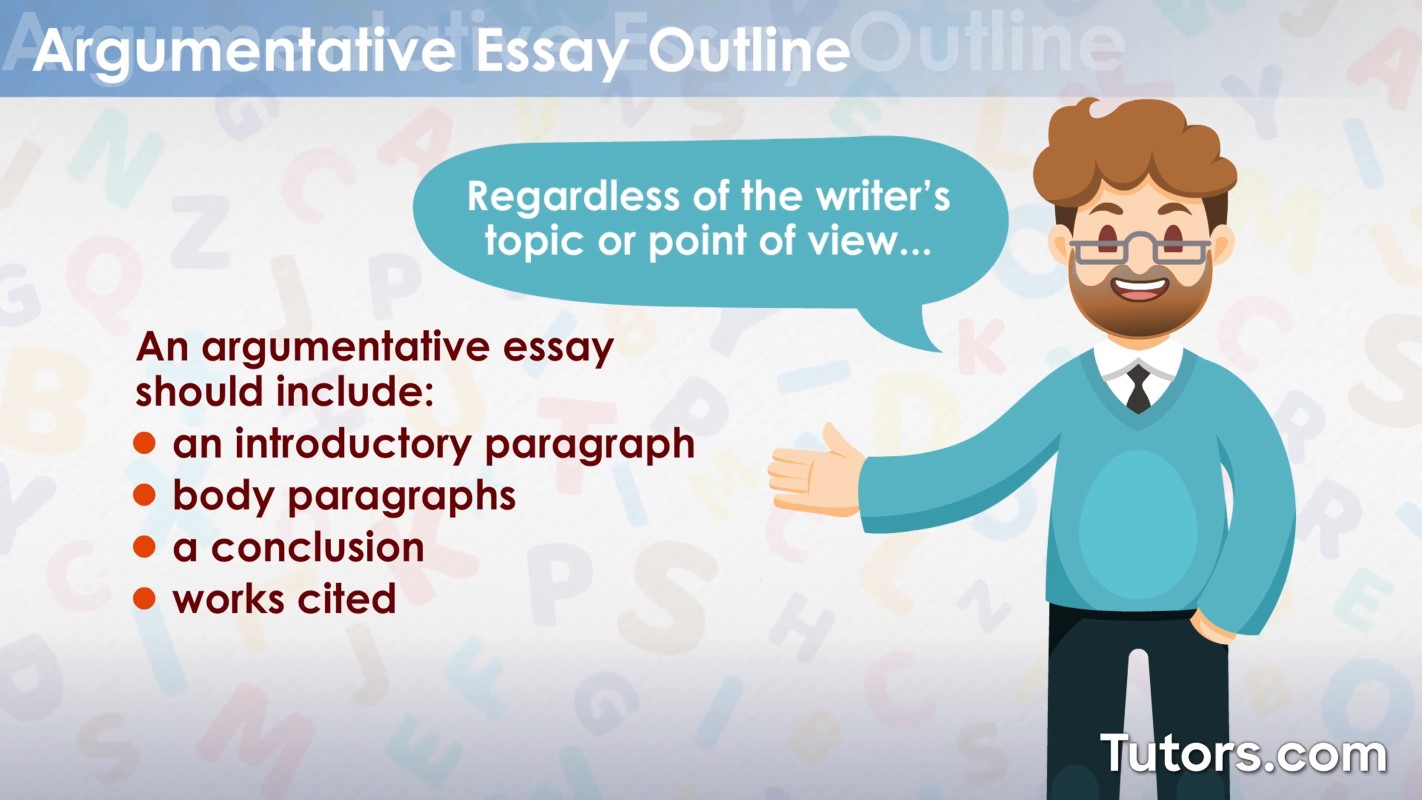Argumentative Essay – Outline, Form, and Examples
What is an argumentative essay?
An argumentative essay requires the writer to investigate a specific topic by collecting and evaluating evidence to establish a position on the subject matter.
When preparing to compose a good argumentative essay, utilize the following steps:
Step 1: Select a topic.
Step 2: Identify a position.
Step 3: Locate appropriate resources.
Step 4: Identify evidence supporting the position. (NOTE: If there is little evidence in support of the claim, consider re-examining the main argument.)

When gathering evidence, use credible sources. To determine the credibility of the source, consider authority, currency, accuracy, and objectivity:
Who is the author? Are they an expert in the field? Has a reputable publisher published the work?
How current is the information in the source? Does the currency of the source matter? Does the age of the source impact the content? Is there newer information that disproves the source’s information?
Can other sources verify the accuracy of the information? Does the information contradict that found in other commonly accepted sources?
Is there any evidence of bias, or is the source objective? Is the research sponsored by an organization that may skew the information?
The following are typically recognized as providing appropriate, credible research material:
Peer-reviewed journals/research papers
Government agencies
Professional organizations
Library databases
Reference books

Writers should avoid using the following sources:
Wikipedia
Social media posts
Out-of-date materials
Blogs
Forums
Step 5: Utilize the research to determine a thesis statement that identifies the topic, position, and support(s).
Step 6: Use the evidence to construct an outline, detailing the main supports and relevant evidence.

Argumentative essay outline
After gathering all of the necessary research, the next step in composing an argumentative essay focuses on organizing the information through the use of an outline:
Introduction
Attention Grabber/Hook
Background Information: Include any background information pertinent to the topic that the reader needs to know to understand the argument.
Thesis: State the position in connection to the main topic and identify the supports that will help prove the argument.
Body
Support 1
Evidence 1
Topic sentence
Identify evidence in support of the claim in the topic sentence
Explain how the evidence supports the argument
Evidence 2
Topic sentence
Identify evidence in support of the claim in the topic sentence
Explain how the evidence supports the argument
Evidence 3 (Continue as needed)
Support 2 (Continue as needed)
Conclusion
Restate thesis
Review main supports
Concluding statement
Invite the audience to take a specific action.
Identify the overall importance of the topic and position.

How to write an argumentative essay
Regardless of the writer’s topic or point of view, an argumentative essay should include an introductory paragraph, body paragraphs, a conclusion, and works cited.
Introduction
Hook
Background information
Thesis
Body Paragraphs
Topic sentence
Evidence
Analysis of evidence
Transition
Conclusion
Rephrased thesis
Review of main ideas
Call to action
Works Cited

Argumentative essay introduction
The introduction sets the tone for the entire paper and introduces the argument. In general, the first paragraph(s) should attract the reader’s attention, provide relevant context, and conclude with a thesis statement.
To attract the reader's attention, start with an introductory device. There are several attention-grabbing techniques, the most common of which consist of the following:
The writer can emphasize the topic’s importance by explaining the current interest in the topic or indicating that the subject is influential.
Pertinent statistics give the paper an air of authority.
There are many reasons for a stimulating statement to surprise a reader. Sometimes it is joyful; sometimes it is shocking; sometimes it is surprising because of who said it.
An interesting incident or anecdote can act as a teaser to lure the reader into the remainder of the essay. Be sure that the device is appropriate for the subject and focus of what follows.
Provide the reader with relevant context and background information necessary to understand the topic.
Conclude with a thesis statement that identifies the overall purpose of the essay (topic and position). Writers can also include their support directly in the thesis, which outlines the structure of the essay for the reader.
Avoid the following when writing the introduction to argumentative writing:
Starting with dictionary definitions is too overdone and unappealing.
Do not make an announcement of the topic like “In this paper I will…” or “The purpose of this essay is to….”
Evidence supporting or developing the thesis should be in the body paragraphs, not the introduction.
Beginning the essay with general or absolute statements such as “throughout history...” or “as human beings we always...” or similar statements suggest the writer knows all of history or that all people behave or think in the same way.
Argumentative essay thesis
The thesis statement is the single, specific claim the writer sets out to prove and is typically positioned as the last sentence of the introduction. It is the controlling idea of the entire argument that identifies the topic, position, and reasoning.
When constructing a thesis for an argumentative paper, make sure it contains a side of the argument, not simply a topic. An argumentative thesis identifies the writer’s position on a given topic. If a position cannot be taken, then it is not argumentative thesis:
Topic: Capital punishment is practiced in many states.
Thesis: Capital punishment should be illegal.
While not always required, the thesis statement can include the supports the writer will use to prove the main claim. Therefore, a thesis statement can be structured as follows:
No Supports: College athletes (TOPIC) should be financially compensated (POSITION).
Supports: College athletes (TOPIC) should be financially compensated (POSITION) because they sacrifice their minds and bodies (SUPPORT 1), cannot hold
Argumentative essay body paragraphs
Body paragraphs can be of varying lengths, but they must present a coherent argument unified under a single topic. They are rarely ever longer than one page, double-spaced; usually they are much shorter.
Lengthy paragraphs indicate a lack of structure. Identify the main ideas of a lengthy paragraph to determine if they make more sense as separate topics in separate paragraphs.
Shorter paragraphs usually indicate a lack of substance; there is not enough evidence or analysis to prove the argument. Develop the ideas more or integrate the information into another paragraph.
The structure of an argumentative paragraph should include a topic sentence, evidence, and a transition.
The topic sentence is the thesis of the paragraph that identifies the arguable point in support of the main argument. The reader should know exactly what the writer is trying to prove within the paragraph by reading the first sentence.
The supporting evidence and analysis provide information to support the claim. There should be a balance between the evidence (facts, quotations, summary of events/plot, etc.) and analysis (interpretation of evidence). If the paragraph is evidence-heavy, there is not much of an argument; if it is analysis-heavy, there is not enough evidence in support of the claim.
The transition can be at the beginning or the end of a paragraph. However, it is much easier to combine the transition with the concluding observation to help the paragraphs flow into one another. Transitions in academic writing should tell the reader where you were, where you are going, and relate to the thesis.
Some essays may benefit from the inclusion of rebuttals to potential counterarguments of the writer’s position.
Argumentative essay conclusion
The conclusion should make readers glad they read the paper. It can suggest broader implications that will not only interest readers but also enrich their understanding in some way. There are three aspects to follow when constructing the conclusion: rephrase the thesis, synthesize information, and call the reader to action.
Rephrased the thesis in the first sentence of the conclusion. It must be in different words; do not simply write it verbatim.
Synthesize the argument by showing how the paper's main points support the argument.
Propose a course of action or a solution to an issue. This can redirect the reader's thought process to apply the ideas to their life or to see the broader implications of the topic.
Avoid the following when constructing the conclusion:
Beginning with an unnecessary, overused phrase such as "in conclusion," "in summary," or "in closing;" although these phrases can work in speeches, they come across as trite in writing
Introducing a new idea or subtopic in the conclusion
Making sentimental, emotional appeals that are out of character with the rest of the paper
Including evidence (quotations, statistics, etc.) that should be in the body of the paper
Argumentative essay examples
Examples of argumentative essays vary depending upon the type:
Academic essays differ based upon the topic and position. These essays follow a more traditional structure and are typically assigned in high school or college. Examples of academic argumentative essay topics include the following:
Advantages or disadvantages of social media
Animal testing
Art education
Benefit or detriment of homework
Capital punishment
Class warfare
Immigration
School uniforms
Universal healthcare
Violence in video games
Argumentative literary essays are typically more informal and do not follow the same structure as an academic essay. The following are popular examples of argumentative literary essays:
“Letter from Birmingham Jail” by Martin Luther King, Jr.
“Death of the Moth” by Virginia Woolf
“Shooting an Elephant” by George Orwell
“Thoughts for the Times on War and Death” by Sigmund Freud
“Does the Truth Matter? Science, Pseudoscience, and Civilization” by Carl Sagan
“Self-Reliance” by Ralph Waldo Emerson